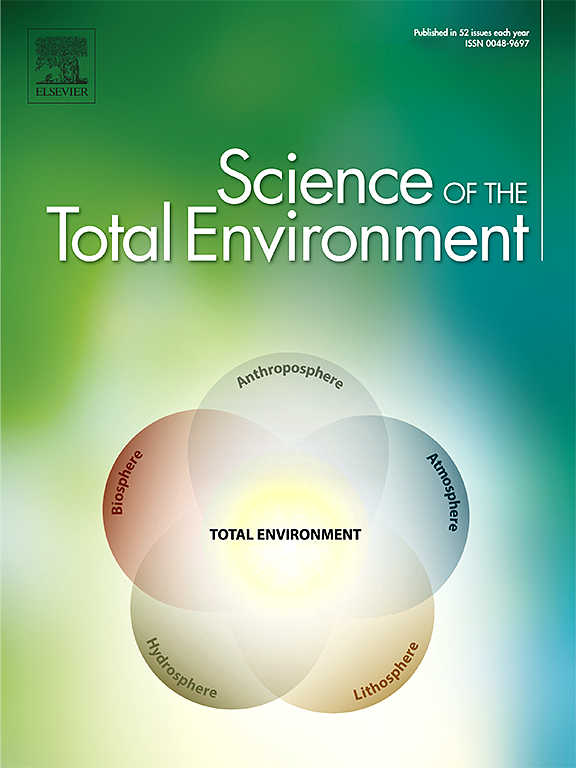Unraveling the shifts in the belowground microbiota and metabolome of Pinus pinaster trees affected by forest decline
IF 8.2
1区 环境科学与生态学
Q1 ENVIRONMENTAL SCIENCES
引用次数: 0
Abstract
Pinus pinaster Aiton (maritime pine) stands are suffering a generalized deterioration due to different decline episodes throughout all its distribution area. It is well known that external disturbances can alter the plant associated microbiota and metabolome, which ultimately can entail the disruption of the normal growth of the hosts. Notwithstanding, very little is known about the shifts in the microbiota and the metabolome in pine trees affected by decline. The aim of our work was to unravel whether bacterial and fungal communities inhabiting the rhizosphere and root endosphere of P. pinaster trees with symptoms of decline and affected by Matsucoccus feytaudi in the National Park of Sierra Nevada (Granada, Spain) showed alterations in the structure, taxonomical profiles and associative patterns. We also aimed at deciphering potential changes in the rhizosphere and root metabolome. Trees infected by M. feytaudi and healthy individual harbored distinct microbial communities at both compositional and associative patterns. Unhealthy trees were enriched selectively in certain plant growth promoting microorganisms such as several ectomycorrhizal fungi (Clavulina) and Streptomyces, while other beneficial microorganisms (Micromonospora) were more abundant in unaffected pines. The rhizosphere of unhealthy trees was richer in secondary metabolites involved in plant defense than healthy pines, while the opposite trend was detected in root samples. The abundance of certain microorganisms was significantly correlated with several antimicrobial metabolites, thus, being all of them worthy of further isolation and study of their role in forest decline.

揭示受森林衰退影响的松地下微生物群和代谢组的变化。
海松(Pinus pinaster Aiton)林分由于其分布区域的不同衰退期而普遍恶化。众所周知,外界干扰可以改变植物相关的微生物群和代谢组,最终可能导致宿主正常生长的破坏。尽管如此,人们对受衰退影响的松树中微生物群和代谢组的变化知之甚少。本研究旨在揭示内华达山脉(西班牙格拉纳达)国家公园内受feytaudi松球菌影响的具有衰退症状的pinaster树的根际和根内圈细菌和真菌群落是否在结构、分类特征和关联模式上发生了变化。我们还旨在破译根际和根代谢组的潜在变化。被feytaudi感染的树木和健康个体在组成和结合模式上都有不同的微生物群落。不健康的树木选择性地富含某些促进植物生长的微生物,如几种外生菌根真菌(Clavulina)和链霉菌,而其他有益微生物(Micromonospora)在未受影响的松树中更为丰富。不健康树木根际中参与植物防御的次生代谢物含量高于健康松树,而根系样品中则相反。某些微生物的丰度与几种抗菌代谢物显著相关,因此它们都值得进一步分离和研究它们在森林衰退中的作用。
本文章由计算机程序翻译,如有差异,请以英文原文为准。
求助全文
约1分钟内获得全文
求助全文
来源期刊

Science of the Total Environment
环境科学-环境科学
CiteScore
17.60
自引率
10.20%
发文量
8726
审稿时长
2.4 months
期刊介绍:
The Science of the Total Environment is an international journal dedicated to scientific research on the environment and its interaction with humanity. It covers a wide range of disciplines and seeks to publish innovative, hypothesis-driven, and impactful research that explores the entire environment, including the atmosphere, lithosphere, hydrosphere, biosphere, and anthroposphere.
The journal's updated Aims & Scope emphasizes the importance of interdisciplinary environmental research with broad impact. Priority is given to studies that advance fundamental understanding and explore the interconnectedness of multiple environmental spheres. Field studies are preferred, while laboratory experiments must demonstrate significant methodological advancements or mechanistic insights with direct relevance to the environment.
 求助内容:
求助内容: 应助结果提醒方式:
应助结果提醒方式:


